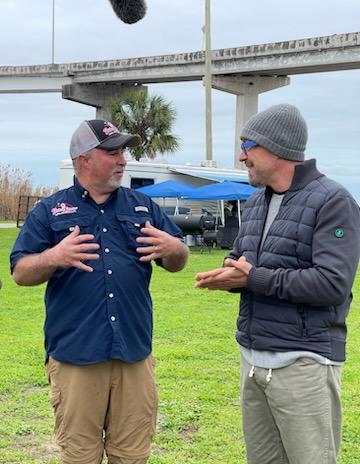Legacy Post Disclaimer
This is a #Legacy post imported from The Apalachicola Time’s previous platform. If you’re experiencing issues with this article, please email us at news@nevespublishing.com.
Tropical Storm Elsa heads toward landfall Wednesday
Areas saturated by recent heavy rains might see flash
flooding because of Tropical Storm Elsa, which could reach hurricane strength
when it makes landfall early Wednesday on the Gulf Coast, Gov. Ron
DeSantis warned Tuesday.
At 8 a.m., Elsa was west of Key West, about 240 miles south
of Tampa, with maximum sustained winds of 60 mph. It was expected to move north
Tuesday off the Gulf Coast, causing rain, wind and storm surge.
While Elsa was forecast to make landfall early Wednesday in
the area of Levy and Citrus counties in largely rural North Florida, heavy
rains are expected along the eastern side of the weather system, which means
most of Florida should feel impacts of the storm, DeSantis said during a news
conference at the state Emergency Operations Center.
Its important that Floridians dont focus on the
(forecast) cone, DeSantis said. Impacts are expected well outside that area.
And if you look at how the storm is, its incredibly lopsided to the east. So
most of the rainfall is going to be east of the center.
DeSantis said he doesnt anticipate widespread evacuations,
but he advised people to heed advice from local emergency officials and to
expect that electricity could be out for several days. He expanded a state of
emergency Monday to include a massive area of North Florida that includes
Alachua, Columbia, Dixie, Franklin, Hamilton, Gilchrist, Jefferson, Lake,
Lafayette, Madison, Marion, Sumter, Suwannee, Taylor and Wakulla counties. An
earlier emergency order included Levy, Citrus and counties farther south.
Emergency Management Director Pam Brownell advised the county commission Tuesday morning that her department was closely monitoring the storm. She said the department is not issuing sandbags, as the storm’s effects would likely not be mitigated by placement of sandbags.
The state is well-equipped to handle the storm, DeSantis
added. We have the state emergency response team working around the clock. We
are going to increase the readiness to a level one. We normally wouldn’t do
that for a tropical storm. But given the part of the state that this is likely
to impact the most, most of those (rural) counties are fiscally constrained
counties.
More than 6,000 utility workers have been placed on
stand-by, while about 250 members of the Florida National Guard have been
called up.
After expected landfall Wednesday morning in North Florida,
the National Hurricane Center anticipates the storm will continue northeast
into Georgia and the Carolinas.
Tropical storm conditions are expected to spread northward
into west-central Florida and the Florida Big Bend region tonight (Tuesday) and
early Wednesday, where hurricane conditions are possible, the center said in
an 8 a.m. advisory. Tropical storm conditions are possible in the watch area
in Florida beginning late tonight.
A hurricane watch was in place from Egmont Key, which is in
the Tampa Bay area, to the Steinhatchee River in the area of Dixie and Taylor
counties.
With tropical storm force winds extending outward 70 miles
from the center, Key West International Airport on Tuesday morning measured a
wind gust of 48 mph.
A tropical storm warning was in effect for part of the
Florida Keys, from Craig Key westward to the Dry Tortugas, and along the West
Coast, from Flamingo in Monroe County to the Ochlockonee River, which is in the
area of Wakulla and Franklin counties in Northwest Florida.
A storm surge warning was in place from Bonita Beach in
Southwest Florida to the Aucilla River, which is at the eastern side of
Jefferson County. The warning includes Tampa Bay.
The watch covers the coastline from Apalachicola to
Alligator Point. The forecast calls for below tropical storm force winds of 10
to 15 mph with gusts to 20 mph, with a potential for wind 39 to 57 mph.
The weather service advises to plan for hazardous wind of
equivalent tropical storm force. Efforts to protect property should now be
underway. Act now to complete preparations before the wind becomes hazardous.
Potential impacts include damage to porches, awnings,
carports, sheds, and unanchored mobile homes, with unsecured lightweight
objects blown about. Many large tree limbs broken off, with a few trees snapped
or uprooted, but with greater numbers in places where trees are shallow rooted.
Some fences and roadway signs blown over.
A few roads may become impassable from debris, particularly
within urban or heavily wooded places. Hazardous driving conditions on bridges
and other elevated roadways is possible, with scattered power and
communications outages.
Localized storm surge is possible, with the potential for up
to 2 feet above ground somewhere within surge prone areas. The primary window
of concern is early Wednesday morning until Wednesday afternoon.
Localized inundation with storm surge flooding is possible
mainly along immediate shorelines and in low-lying spots, or in areas farther
inland near where higher surge waters move ashore. Sections of near-shore roads
and parking lots may become overspread with surge water. Driving conditions
could be dangerous in places where surge water covers the road.
The forecast is for moderate beach erosion, with heavy surf
also breaching dunes, mainly in usually vulnerable locations, with strong rip
currents.
Expect minor to locally moderate damage to marinas, docks,
boardwalks, and piers. A few small craft may be broken away from moorings.
Peak rainfall amounts are for an additional 1 inch, with a
potential for moderate flooding rains. Emergency plans should include the
potential for moderate flooding from heavy rain. Evacuations and rescues are
possible.
Moderate rainfall flooding may prompt several evacuations
and rescues. Rivers and tributaries may quickly become swollen with swifter
currents and overspill their banks in a few places, especially in usually
vulnerable spots. Small streams, creeks, and ditches overflow.
Flood waters can enter some structures or weaken
foundations. Several places may experience expanded areas of rapid inundation
at underpasses, low-lying spots, and poor drainage areas. Some streets and
parking lots take on moving water as storm drains and retention ponds overflow.
Driving conditions become hazardous. Some road and
bridge closures.
The weather service said the situation is unfavorable for
tornadoes; tornadoes are not expected.





Meet the Editor
David Adlerstein, The Apalachicola Times’ digital editor, started with the news outlet in January 2002 as a reporter.
Prior to then, David Adlerstein began as a newspaperman with a small Boston weekly, after graduating magna cum laude from Brandeis University in Waltham, Massachusetts. He later edited the weekly Bellville Times, and as business reporter for the daily Marion Star, both not far from his hometown of Columbus, Ohio.
In 1995, he moved to South Florida, and worked as a business reporter and editor of Medical Business newspaper. In Jan. 2002, he began with the Apalachicola Times, first as reporter and later as editor, and in Oct. 2020, also began editing the Port St. Joe Star.